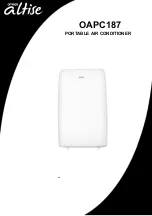
4. Cut off the remaining foam insulation.
5. If necessary, bend the pipe to fit along the bottom of the indoor unit.
Then pull it out through the appropriate hole.
The pipe should not project from the rear of the indoor unit.
The bending radius should be 100 mm or more.
6. Pass the pipe through the hole in the wall.
7. For further details on how to connect to the outdoor unit and evacuate the air, refer to page 39~41.
• Tighten the flare nut with torque wrench according to specified method.
If the flare nut is over-tightened, the flare may break and cause refrigerant gas leakage.
• DO NOT WALL UP THE PIPE CONNECTION !
All refrigerant pipe connection must be easy accessible and serviceable.
• The pipe will be insulated and fixed permanently into position after finishing the installation and the gas leak test;
refer to page 43 for further details.
Evacuating the indoor unit
Unscrew the caps
Pipes
• The remaining air in the Refrigeration cycle, which contains moisture,
may cause malfunction on the compressor.
• Always contact the service center or a professional installation agency
for product installation.
• To prevent dirt or foreign substances from getting into the pipes during
installation, do NOT remove the caps completely until you are ready to
connect the pipes.
The length of the pipe can be:
• Extended up to : see table page 28
• Shorten up to: see page 28
If you need a pipe longer than 7.5 meters:
• You must add refrigerant to the pipes; otherwise, the indoor unit may freeze.
Cutting or extending the pipe
1. Unscrew the caps at the end of each pipe.
All inert gas exhausts from the indoor unit.
The indoor unit is supplied with inert gas (nitrogen).
Before installing the unit, check if nitrogen gas flow out of indoor unit.
If this one isn’t true, DO NOT INSTALL THE UNIT since leakage could be inside the indoor unit.
English-35
SA_BORACAY_IB&IM_EN_DB98-34690A_del_screw.indd 35
5/14/2015 2:49:15 PM














































